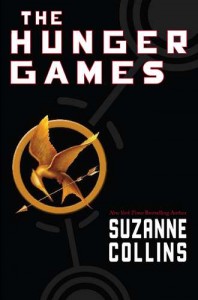 The Hunger Games by Suzanne Collins
The Hunger Games by Suzanne Collins
Scholastic, 374 pages
Could you survive on your own, in the wild, with every one out to make sure you don’t live to see the morning?
In the ruins of a place once known as North America lies the nation of Panem, a shining Capitol surrounded by twelve outlying districts. The Capitol is harsh and cruel and keeps the districts in line by forcing them all to send one boy and one girl between the ages of twelve and eighteen to participate in the annual Hunger Games, a fight to the death on live TV.
Sixteen-year-old Katniss Everdeen, who lives alone with her mother and younger sister, regards it as a death sentence when she steps forward to take her sister’s place in the Games. But Katniss has been close to dead before—and survival, for her, is second nature. Without really meaning to, she becomes a contender. But if she is to win, she will have to start making choices that will weigh survival against humanity and life against love.
I was never a fan of dystopian or post-apocalyptic literature. The thought of reading a book where the world I know has been destroyed by natural or human forces (or both), or one ruled over by oppressive totalitarian government is depressing. With all the bad news on TV and in the papers, I don’t need to escape to another reality that pains an even bleaker picture of the future. So when I first heard of The Hunger Games by Suzanne Collins from a fellow Filipino book blogger, I just skimmed over her review. Kids killing other kids–dystopia and gore? No, thanks.
Then, at last year’s Manila International Book Fair last year, I stopped at the central display of National Bookstore. There was a huge display for The Hunger Games and its sequel, Catching Fire, and a TV interview of Suzanne Collins playing on loop. The lady beside me was so enthusiastic about the books and, not wanting to waste my trip to the fair, I ended up getting both books despite my apprehension. Book-wise, that choice was probably the best I made last year.
The Hunger Games is set in the future in a nation called Panem, formerly known as North America, before a series of disasters decimated the once successful nation. Panem is ruled by the Capitol and divided into thirteen districts, each with a specific industry that sates the Capitol’s lavish needs. Seventy-four years ago, the thirteen districts revolted against the Capitol but were defeated. To prevent further uprisings, the surviving 12 districts were punished through the annual Hunger Games: each district provides “tributes†— a boy and a girl between the age of 12 and 18 — through a lottery called “reaping.†The tributes, after much pomp and ceremony, are sent to the Hunger Games arena where they are made to fight each other to the death in a televised extravaganza, until only one remains. The last remaining survivor is declared winner, ensuring that his/her family and neighbors will have enough food for the rest of the year.
We meet the heroine, sixteen-year-old Katniss Everdeen, on the morning before the reaping, with her best friend Gale, in the woods outside of District 12. In the course of the first few pages of the book, we learn a lot about her family background, her role as provider for her family, and the fact that her entire existence revolves around keeping her sister, Prim, safe. When Prim’s name is drawn in the reaping, Katniss volunteers in her stead, knowing that her decision likely means her death.
Katniss has to compete not only against tributes from the richer districts, many of whom have been training to participate in the Hunger Games all their lives, but with Peeta Mellark, a young man she has a history with. As the Games go on and the tributes fall one by one, Katniss has to draw both on her learned skills and rock-hard determination not only to survive, but to make the hard decisions necessary to make it back to her family.
The premise may seem a bit complicated, but Collins weaves it into the story in a manner that makes it comprehensible and unobtrusive, as readers are plunged right into the action. The first thing readers will notice in The Hunger Games is the solid world building. Panem, the Capitol and its Districts, were described in such a matter-of-fact tone and detail that it felt real. It wasn’t exactly the numerous details that made the world so convincing, but the way that Panem was portrayed not just as a place, but as a living, breathing character in the novel. The contrast between the rich Capitol and poor District 12 was stark, and disturbingly familiar, almost a mirror to the societal division between the rich and the poor here in the Philippines. Click here to read the rest of the review.
Rating: [rating=4]
2010 Challenge Status:
* Book # 62 out of 100 for 2010
My copy: Hardcover, from National Bookstore
Cover: suzannecollinsbooks.com
Blurb: Goodreads

I had the same apprehensions as you had, as I’m not a fan of dystopia either, and like you, I’m glad I took the plunge. I reread the books last Saturday and they were every bit as good as they were the first time!
I’ve also been reading Suzanne Collins’ Underland Chronicles — just started book 3– and they’re pretty good, too!
Blooey! It’s your review that got me reading these books. :) Thank you!
I finished re-reading Catching Fire last week, and I think it was more awesome than I first remembered it. :D I can’t wait for next week — still contemplating if I can file a leave the next day just so I could have the day for reading! :D
Pingback: Follow Friday / Book Blogger Hop (2) | One More Page
Pingback: Delirium | One More Page
Pingback: Divergent | One More Page